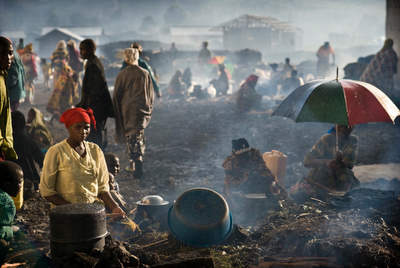
The past few weeks have seen a flurry of activity aimed at achieving greater transparency and accountability with respect to the U.S. government’s practice of “targeted killing” (primarily through the use of drones).
To begin, the UN special rapporteur on counter-terrorism and human rights, Ben Emmerson, announced in late January the launch of an investigation into the “civilian impact” and “human rights implications” of drone attacks and other targeted killings by the U.S. and other states. The rapporteur claimed that such attacks pose a serious challenge to the existing framework of international law, and therefore require the development of new legal mechanisms to regulate use and ensure accountability. He also warned that if states engaged in drone attacks do not establish effective, independent, and impartial investigations of their actions, it might be necessary for the United Nations to do so. (Note: The UN investigation will examine 25 different cases of drone attacks, not all directed by the U.S. However, it remains the case that U.S. policy is a main focus of attention, particularly for China, Russia, and Pakistan, the three states that called for the investigation within the Human Rights Council).
There is little prospect that Emmerson’s announcement will lead the Obama administration to make significant efforts to provide greater transparency. When the UN special rapporteur on extrajudicial, summary, or arbitrary executions made inquiries into drone attacks in 2002, and again in 2005, the U.S. responded by claiming that such incidents do not fall within the jurisdiction of the rapporteur, given that the applicable law is the international law of armed conflict. Thus, while there are legitimate and important questions to be asked about which body of law applies in the area of counter-terrorism, U.S. lawyers are likely to continue to contest the application of human rights principles to what they contend is a “war context.” In addition, the U.S. will no doubt be suspicious of the motives of those states that have called for the investigation.
But while these international calls for more openness and oversight are likely, at least in the short term, to have little impact on U.S. practices, domestic calls to provide more detail on the processes by which targets are selected and killed are more serious for the Obama administration. Earlier this week, NBC News leaked an unclassified white paper, drafted by the U.S. Justice Department, outlining the legal arguments in favour of the U.S. government’s right to engage in targeted killing of U.S. citizens abroad when such citizens are deemed to be actively involved in plotting terrorist attacks against the United States.
The white paper was meant to quench the thirst of U.S. lawmakers, particularly those on the Senate Intelligence Committee, for more information about how the CIA and the Pentagon define a legitimate target for counter-terrorist strikes – particularly when aimed at American citizens who have firm rights under the Constitution. However, the release only whetted their appetite (to continue the metaphor) and intensified the call for the release of the full, classified Justice Department documents that address the question of when the executive can order the killing of a citizen based on secret intelligence and without trial. Yesterday, U.S. President Barack Obama bowed under the pressure, and agreed to make the documents available to the committee (a move that will help to address cries of hypocrisy, since Obama had called for the Bush administration to publish its classified memos relating to torture).
Meanwhile, on Tuesday, in a federal district court in Washington, D.C., the American Civil Liberties Union (ACLU) and the Center for Constitutional Rights filed a brief requesting that a federal judge not dismiss a case of litigation against senior CIA and military officials for the 2011 targeted killing of Anwar al-Awlaki (a suspected al-Qaeda leader) and his 16-year-old son, both U.S. citizens. The case would bring out into the open many of the U.S. government’s current assumptions and arguments about the legitimacy of drone attacks. The defendant (effectively the Obama administration) has asked for dismissal on the grounds that the court has no jurisdiction over acts that occur in the conduct of armed conflict, and that are therefore regulated by the laws of war. The plaintiff, however, is arguing that the strikes violate the U.S. Constitution (by failing to provide due process to U.S. citizens before their execution) and the international law of armed conflict (by failing to observe principles of distinction (i.e., civilian immunity) and proportionality).
Finally, there was the spectre, on Thursday, of John Brennan, Obama’s high-ranking counter-terrorism adviser and one of the primary architects of the administration’s policy on drone attacks, being grilled by the Senate during the confirmation hearings for his appointment as the new director of the CIA. Brennan could barely get out the words of his opening statement, as protestors against U.S. drone attacks disrupted the hearings. In rare public statements prior to yesterday, Brennan has insisted that the administration’s practices related to targeted killing are “ethical” and “just.” When senators questioned him yesterday on current policy, Brennan reiterated this defence of the drone program, insisting that lethal force was a last resort and that the president himself is ensuring that “any actions we take will be legally grounded, will be thoroughly anchored in intelligence” and will have “the appropriate approval before any action is contemplated.” When pressed on how targets for drone attacks are selected, he responded that they are analyzed on a “case by case basis” as part of a process involving co-ordination with other agencies of the U.S. government.
Such practices of selection are decidedly not, as Brennan’s testimony implies, seen as subject to any kind of judicial review. This stance was pronounced loudly and clearly in the leaked white paper, which insisted that there is “no appropriate judicial forum” in which to evaluate these issues. U.S. courts should not play a role in reviewing or restraining targeted killings, argues the Justice Department lawyers, since it would effectively enable them to “supervise inherently predictive judgments” by the president and his national security advisers “as to when and how to use force against an enemy against which Congress has already authorized the use of force.” The white paper also draws (selectively) on earlier judicial statements to argue that in matters of foreign policy and national security, a certain level of discretion is to be given to the executive. In short, the Justice Department believes that “due process” (a right of all U.S. citizens) does not mean “judicial process” in situations of national security. Instead, we are to trust the decision-making processes and judgments of the executive branch.
In what the ACLU calls a “stunning overreach of executive authority,” the Justice Department concludes that it is lawful for the U.S. government to kill a U.S. citizen if “an informed, high-level official” decides that 1) the target is a ranking figure in al-Qaeda that poses an “imminent threat” of violent attack against the United States; and 2) the capture of such a figure is not feasible (because such a capture cannot “be physically effectuated during the relevant window of opportunity,” because the “host country” where the figure is operating does not give its consent for the killing, or because capture would pose “undue risk” to U.S. personnel).
According to the white paper, the president has authority to respond, through targeted killings, to the threat posed by al-Qaeda in light of a variety of legal sources:
- His constitutional responsibility to protect the country;
- The “inherent right” of the U.S. to national self-defence under international law;
- The existence of a non-international armed conflict with al-Qaeda (which U.S. officials insist legitimizes the use of force not only in “hot” places like Afghanistan, but also in countries outside the area of “active hostilities,” such as Pakistan and Yemen); and
- Congress’ authorization of the use of force against terrorists as part of this non-international armed conflict.
Thus, it seems, U.S. citizenship does not “immunize” a senior operational leader of al-Qaeda from “a use of force in national self-defence.”
While this lack of oversight or review is the aspect of the white paper that is garnering the most attention, the other troubling part of the memo is its conception of what constitutes an “imminent threat.” In contrast to the traditional conception of imminence in international law, which usually requires evidence of a specific attack in the immediate future, the Justice Department claims that it is sufficient for a target to be “generally engaged” in terrorist activities aimed at the United States. So, why is the imminence restriction relaxed? The document claims that terrorism is not marked by one “massive attack” or “one isolated incident,” but, rather, is “drawn out,” “patient,” and “sporadic.” Moreover, to wait for firm evidence of an attack in the immediate future would leave no time for the U.S. to defend itself – or, at the very least, would greatly reduce its “defensive options.”
The Justice Department’s core argument is that the U.S. is likely to have only “a limited window of opportunity within which to defend Americans in a manner that has both a likelihood of success and sufficiently reduces the probabilities of civilian casualties.” As a result, the test for selecting a target has to be broader: Was the target a senior operational leader in al-Qaeda or “an associated force”? Is he/she personally and continually involved in planning attacks against the U.S.? And is there any evidence that he/she has renounced association with al-Qaeda? It is the answers to these questions, says the Justice Department, that determine whether a drone should be sent.
While parts of this logic make sense in the abstract, and do make an attempt to come to grips with the unusual nature of the threat posed by terrorism, the rationale conforms neither to the experience with drone attacks to date (which have incurred heavy civilian casualties) or to the efforts of other countries, such as Israel (more on this below), to respect the imminence restraint. In sum, the definition of imminence that the Obama administration is promoting is extraordinarily broad, opening the door to killings in cases where there is no evidence of a specific attack being planned in the immediate future, and – by implication (since more attacks would be made possible) – to a higher risk of civilian casualties.
Finally, there are probing questions to be asked about how seriously the U.S. contemplates the option of capture. In press reports this week coinciding with John Brennan’s testimony, officials in Yemen have been quoted as saying that they believe they are not being given sufficient opportunities for their own counter-terrorism squads (trained by the U.S., by the way) to go after al-Qaeda operatives. In addition, by arguing that capture cannot be pursued when there is “undue risk” to American personnel, the U.S. is making a moral judgment about whose lives should be prioritized. This judgment becomes all the more important when the deaths resulting from drone attacks are also civilian ones. Ethical debates about the conduct of war have long questioned the legitimacy of “force protection” as an operating principle for those engaged in armed conflict. Both law and morality call upon military (and civilian) leaders to take civilian protection seriously.
Many may argue that a lack of judicial review and an elastic interpretation of imminence are necessary in the murky world of counter-terrorism, where democratic governments need to fight ruthless enemies without one hand tied behind their back. But there is evidence from Israel that this need not be the case. As noted by Amos Guiora, former legal advisor to the Israeli Defence Forces on targeted killing, the Israeli Supreme Court has ruled on two occasions that while targeted killing in the context of counter-terrorism is legal, it must be limited and subject both to rigorous criteria and – because target selection inevitably relies heavily on intelligence – judicial review. The court itself was instrumental in helping to refine the definition of a legitimate target, insisting that there needed to be a specific and immediate threat posed by a specific individual.
There is an argument, which Andrew Cohen hints at in a blog post for The Atlantic that this is also where the U.S. will ultimately end up. Cohen contends that the white paper should be seen not as actual U.S. policy, but rather as a kind of “trial balloon” that the executive branch is floating to assert more power for itself, and to which other branches of the U.S. government will rightly respond. “It’s a pitch,” he writes, “the staking out of a position in advance of a Washington battle yet to come.” As Cohen notes, it is frequently the case that the executive branch gets out ahead of the judicial branch when it comes to interpreting the power it has been given by the legislative branch (in this case, the Authorization for Use of Military Force, a resolution that Congress passed in September 2001, in the context of the “war on terror”). But the courts will eventually catch up, and the legislature will demand refinement and parameters on what it has agreed to.
This interpretation would put a positive spin on the events we have seen over the past few weeks. The push for transparency will lead to better arguments, and therefore better policy. The full U.S. system is “doing its thing,” and the result of that decentralized, bottom-up – and sometimes chaotic – process, which involves not only the three branches of judiciary, legislature, and executive, but also civil society, will ultimately result in a correction of draconian policy. As one Canadian diplomat once said to me, “The U.S. always does the right thing – eventually.”
But many will be less inclined to have this level of faith in a long-run correction. There are several chilling aspects to the white paper, not least of which is the broad use of a “public authority justification” for what many analysts believe is effectively a practice of murder (especially when meted out against U.S. citizens). After all, as John Maynard Keynes once said, “In the long run we are all dead.”
Jennifer Welsh is Professor in International Relations, University of Oxford and Co-editor (with Vaughan Lowe, Adam Roberts, and Dominik Zaum) of The United Nations Security Council and War: The Evolution of Thought and Practice since 1945, (Oxford University Press, 2008) and (with Ngaire Woods) of Exporting Good Governance: Temptations and Challenges in Canada’s Aid Program (Wilfred Laurier University Press, 2007).
This post originally appeared on opencanada.org, the website of the Canadian International Council. It is re-published here with the permission of the author.
Recent posts by Jennifer Welsh: ‘Clock is Ticking: Canada must show Arctic leadership‘.







No Comment